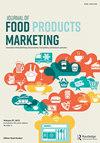被视为绿色?评估环保包装线索的突出性和绿色性
IF 2.4
Q2 BUSINESS
引用次数: 7
摘要
摘要环保产品越来越受欢迎。要考虑购买,它们必须(1)足够突出,(2)被视为环保(“绿色”)。目前的论文研究了隐性(包装材料)和显性(生态标签)包装线索是否可以促进这种显著性和绿色感知。我们进行了一种混合方法,在受试者中进行实验,使用自我报告测量来评估感知的绿色度,并将鼠标追踪作为评估显著性的探索性测量方法。最后,我们探讨了绿色消费主义作为一种个人价值观是否会调节这些影响。结果证实,暗示环境友好的内隐和外显线索都会对感知的显著性和绿色产生积极影响。此外,我们发现,隐性和显性线索在影响显著性和绿色感知方面似乎大多是独立的,而绿色消费主义并不是大多数包装效果出现的先决条件。因此,本研究为包装在食品营销中的作用提供了重要的新的理论和实践见解。本文章由计算机程序翻译,如有差异,请以英文原文为准。
Seen as Green? Assessing the Salience and Greenness of Environmentally Friendly Packaging Cues
ABSTRACT Environmentally friendly products become increasingly popular. To be considered for purchase, they must be (1) sufficiently salient and (2) perceived as environmentally friendly (“green”). The current paper investigates whether implicit (packaging material) and explicit (eco-labeling) packaging cues can facilitate such salience and greenness perceptions. We conducted a mixed-method, within-subjects experiment using self-report measures to assess perceived greenness, and mouse tracking as an exploratory measurement method to assess salience. Finally, we explored whether green consumerism, as a personal value, moderates these effects. Results confirm that both implicit and explicit cues that signalize environmental friendliness positively influence perceived salience and greenness. Furthermore, we find that implicit and explicit cues seem mostly independent in affecting salience and greenness perceptions and that green consumerism is no prerequisite for most of these packaging effects to emerge. As such, this research provides important new theoretical and practical insights on the role of packaging in food marketing.
求助全文
通过发布文献求助,成功后即可免费获取论文全文。
去求助
来源期刊

Journal of Food Products Marketing
BUSINESS-
CiteScore
5.70
自引率
6.90%
发文量
17
期刊介绍:
From food promotion and advertising through new food product development and consumer behavior research, the Journal of Food Products Marketing provides timely, practical articles that keep food marketers on the cutting edge of their profession. The journal includes refereed research studies as well as opinions, guidelines, and speeches by practitioners that contribute to the better practice and understanding of food marketing. The journal provides a single forum for both food marketing academicians and food marketing practitioners.
 求助内容:
求助内容: 应助结果提醒方式:
应助结果提醒方式:


